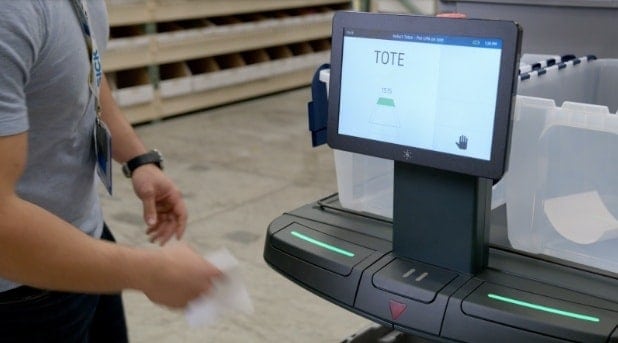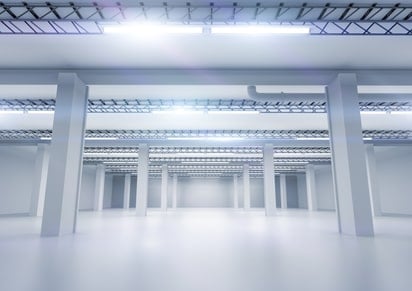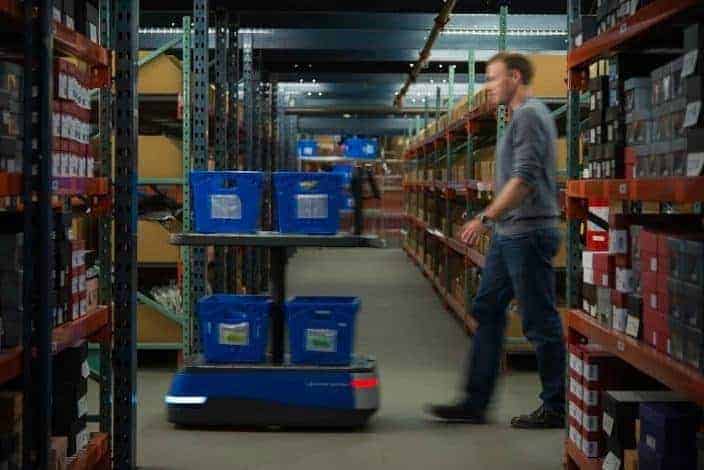Many warehouses are looking to leverage automation to improve operational efficiency, but building an efficient automated warehouse system requires careful selection of the right technologies. To fully optimize your processes and achieve efficiency, you must choose technologies that integrate well and work together seamlessly.
Let’s take a look at the new technologies you need — and why you need them – when building an automated warehouse system:
- Interoperability between warehouse systems and software
- Cloud computing and storage
- Real-time tracking mechanisms
- Collaborative mobile robots
- Access to on-demand warehousing
- Data analytics and artificial intelligence
- Cartonization software
- Drones
- Automated forklifts
- Older automation technologies
- How does automation affect the physical layout of a warehouse?
- How much does it cost to automate a warehouse?
- Additional Resources on Warehouse Automation Systems
Interoperability between warehouse systems and software

First and foremost, interoperability is key. Your warehouse systems and software need to be able to share data between them, but those systems are not all the same and may have different data formats. Interoperability solves this challenge by allowing applications to seamlessly share data, such as inventory data, shipping information and purchase orders. Without interoperability, data remains siloed and you can’t benefit from a comprehensive, bird’s-eye view of your warehouse operations.
Application programming interfaces (APIs) are the most common technology driving interoperability, not only in the warehouse but also in other industries, such as healthcare. APIs enable applications to collect data from disparate warehouse information systems, supporting integration and eliminating data silos. Integrating data from disparate sources also supports data analytics and artificial intelligence solutions, which we’ll discuss later in this guide.
Cloud computing and storage

When it comes to automating your warehouse systems, cloud computing and storage offers several benefits, including reduced infrastructure and maintenance costs. Rather than setting up and maintaining an on-site data center, cloud computing provides a more scalable solution while reducing the need for an in-house IT department. Cloud computing also makes system integration possible, meaning you can integrate multiple systems for ease of access.
As warehouses generate and collect more data from various information systems and from the supply chain, cloud computing is more necessary for the modern warehouse than ever. Cloud computing not only makes system integration easier, but it also supports collaboration between supply chain partners.
Real-time tracking mechanisms

Modern warehouses use real-time tracking mechanisms like RFID, which use radio waves to transmit data between tags or labels and computer and information systems. The benefits include increased visibility into your inventory throughout the supply chain, including shipping and delivery, ensuring that the right items get to the right customers at the right time.
Real-time tracking mechanisms like RFID improve stock and demand generation visibility, allowing warehouses to maintain leaner inventory and reduce overhead costs. Some innovators are experimenting with pairing RFID with drones to automate delivery processes.
Collaborative mobile robots

In 2016, CBRE Group released a report exploring the impact of robotics and automation, autonomous trucks and 3-D printing on supply chains, predicting that these three technologies would have a transformational impact on distribution over the next decade. Adoption of automation in warehouses and on highways is driven by the growth of faster fulfillment cycles and e-commerce, according to CBRE, noting that these three technologies are on track to achieve widespread use by 2025.
One often-cited concern is the impact of automation on the workforce, but automation doesn’t necessarily replace the work of human workers. Collaborative mobile robots, for example, enhance the work of human warehouse associates by guiding them through the picking process to increase productivity and accuracy.
Another benefit of collaborative mobile robots to automated warehouse systems is rapid implementation. With a solution like 6 River Systems, you can go live in weeks instead of the months necessary for implementing traditional automation solutions. With cloud-based algorithms that manage work in real-time, 6 River Systems reduces steps between tasks and eliminates the long walk.
Access to on-demand warehousing

On-demand warehousing gives companies access to additional warehouse space that’s used, rented or leased on a temporary basis to accommodate short-term capacity needs. Warehouse matching services like Flexe connect companies in need of warehouse space with those that have space available, serving as a middle-man of sorts to facilitate share-economy warehousing.
The benefits of on-demand warehousing are obvious: it allows warehouses to adapt more readily to shifts in market demand, while reducing or eliminating the need to invest in additional infrastructure that would otherwise go unused for part of the year. Conversely, the on-demand warehousing model also enables warehouses who have unused infrastructure to monetize that space and reduce overhead costs.
Data analytics and artificial intelligence

Collecting raw data with real-time tracking and other tools is useful, but data analytics and artificial intelligence (AI) are the solutions that turn raw data into actionable insights. Data analytics and AI tools enable operators and managers to make timely data-driven decisions, responding to existing information in real-time and even taking proactive measures in response to predictive analytics data.
As mentioned previously, interoperability made possible with APIs or other integration tools eliminates data silos. In turn, data analytics and AI solutions derive insights based on a more comprehensive data set to support decision-making with more context (input from the various warehouse information systems rather than input from a single solution). For example, it’s better to make decisions about ordering inventory based on historical order data combined with supplier data and market trends data than it is to make the same decision based on historical order data alone.
Modern warehouses use technologies like data analytics and AI to optimize picking routes, for inventory and capacity planning and more. Other technologies have built-in AI solutions, such as 6 River Systems’ Chuck, which uses AI and machine learning to prioritize tasks based on work assignments and the status of the warehouse floor. Chuck optimizes picking routes in real-time and even spots risks to keep your associates on-task and maximize productivity.
The benefits of data analytics and AI aren’t just for warehouses. Top logistics companies, for example, pair real-time vehicle tracking with AI to streamline fleet planning and improve delivery speed by re-routing vehicles in real-time to avoid potential weather or traffic delays.
Cartonization software

It’s not always easy to estimate the correct carton size, even for seasoned packing associates. When an associate chooses the wrong carton size, they end up back-tracking and repeating tasks for the same order. If the carton isn’t too small for the order, associates may pack the order in the too-large carton anyway, which isn’t an efficient use of resources.
Cartonization software calculates the ideal carton size for each order based on SKU dimensions, product weight data and other factors. That means associates don’t need to guess the right carton size, eliminating wasteful spend on too-large shipping boxes and subsequent shipping costs and the labor spent repacking orders. Cartonization software supports lean, single-touch pick and pack processes, especially when it’s paired with an efficient picking technology like collaborative mobile robots.
Drones

While they’re not yet considered an essential technology for an automated warehouse system, there’s a lot of hopeful speculation about the role of drones in the future warehouse. Some companies are already experimenting with drones for inventory management and delivery. For example, drones can speed up inventory counts by scanning barcodes and recording item location information in the warehouse management system up to 50 times faster than manual data capture. According to The Future Warehouse, any discrepancies identified by the drone stock counting process are checked manually by human workers to confirm and address discrepancies or reconcile errors.
Walmart tested an aerial inventory technology, powered by drones, in 2016. According to a report from The New York Times, the trial included “sensor-equipped drones [that] flew in the aisles of a distribution center and alerted management to products that were close to being out of stock or were not in their assigned slot.”
Another example is Amazon’s Prime Air, “a future delivery system from Amazon designed to safely get packages to customers in 30 minutes or less using unmanned aerial vehicles, also called drones.” While it’s still in the development phase, it’s no surprise that the largest online retailer is an early pioneer of drone technology in the supply chain. That said, Amazon isn’t the first company to get FAA approval for drone delivery; as Recode reports, that achievement goes to Alphabet’s Wing Aviation program, an offshoot of Google. A use case still in its infancy, the use of drones for delivery could have big implications for neighborhood stores, not to mention UPS, FedEx and the U.S. Postal Service.
Automated forklifts

While they’re not among the newest warehouse automation technologies, the use of automated forklifts has grown in recent years. Like collaborative mobile robots, automated forklifts don’t require investing in new infrastructure. In particular, newer models don’t require special floor tape or other fixed infrastructure to direct them throughout the warehouse. For the most part, they can operate in the same routes used by your human workers but handle tasks that would typically involve long travel times for stock picking or put-away tasks.
Typically equipped with sensors that detect activity in their path, automated forklifts can avoid collisions with other vehicles or human associates. As many forklift accidents are attributed to inadequate training or human error, automated forklifts can improve safety assuming sensors and other safety mechanisms are functioning properly. Thanks to these same sensors, automated forklifts offer more precise and secure load handling, resulting in reduced product damage from handling. They can also improve productivity by handling time-consuming and repetitive tasks, freeing up your associates up for more value-added tasks.
Older automation technologies

Automation technologies as a whole aren’t new; warehouses have been embracing them for years. As such, there are older automation technologies that are being replaced by flexible collaborative picking robots, such as:
- Automated Storage and Retrieval Systems (AS/RS) — Because they can operate with smaller warehouse aisles and taller racks, AS/RS improve the use of warehouse floor space and improve cube utilization. However, they’re expensive to install and often require extensive customization, as well as substantial infrastructure investments. Additionally, AS/RS maintenance requirements are greater than many other warehouse automation solutions.
- Pick-to-light and put-to-light systems — Using lights or LED displays, pick-to-light and put-to-light systems point associates to the correct location for items. While these systems can improve accuracy, they don’t get rid of long walks in the warehouse and don’t offer much guidance to associates beyond pinpointing the right locations for stock picking and putting. These systems require confirmation when items are picked, or for stock putting, associates manually distribute items to their proper locations and then turn off the light when the task is complete.
- Voice tasking technology — With voice tasking technology, also known as voice picking technology, warehouse associates wear headsets to communicate with the warehouse management system, which is equipped with speech recognition and synthesis capabilities. Associates can speak the last few digits of an item’s SKU to confirm that they’re picking the right item. This system allows associates to work with both hands free and without referring to written orders or instructions, although wearing a headset can interfere with an associate’s ability to hear forklifts and other vehicles approaching. Voice tasking technology also leaves room for human error.
- Automatic guided vehicles (AGVs) — AGVs navigate a warehouse using wires attached to the floor with magnetic strips, laser navigation and vision navigation aided by live video streams from cameras placed throughout a warehouse facility. They require little human intervention to work and may be used in applications that aren’t ideal for human workers, such as extreme temperatures. AGVs can be costly to implement, however, and they’re not as flexible, limited to set routes and requiring changes to the warehouse infrastructure. They may also require more maintenance compared to newer automation solutions.
- Automated sortation systems — There are a variety of types of automated sortation systems, designed to sort items of varying sizes and quantities. The biggest downside to these systems is that they require significant infrastructure investments. They’re also fixed in place and not as flexible compared to other automation technologies. For more on sortation, read “How Sortation Boosts Your Competitive Advantage.”
How does automation affect the physical layout of a warehouse?
Whether you’re overhauling parts of your manual operations or leveraging a fully integrated solution, warehouse automation delivers several competitive advantages. This includes:
- better lead-times
- product security and condition
- improved order accuracy
- reduced operating costs
- reduced facility size
- efficient utilization of warehouse space
- better productivity
- improved ergonomics
However, the effective utilization of warehouse floor space is one of the most significant but overlooked benefits of warehouse automation.
The extent by which the layout of a warehouse changes during the deployment of automation systems depends on the kind of system being deployed. Most automated systems eliminate the need for wide aisles — a must when human operators need to travel through the warehouse to handle order fulfillment activities.
This is because robots can efficiently travel through less spacious environments and better handle product retrieval and storage in congested warehouses. Automation enables businesses to reduce the footprint of their warehouse (and other associated costs) while increasing the efficiency of order fulfillment activities.
In modern distribution operations, warehouse control software, AGVs, AMRs and ASRS all work together to optimize replenishment, storage and order fulfillment activities…at a fraction of the cost and supervisory headaches required by manual labor. With automated storage and retrieval systems, businesses can design their warehouse to maximize the use of space, both vertically and horizontally.
If you’re concerned about the cost and hassle of redesigning your warehouse space for automated systems, you can invest in collaborative mobile robots. Cobots do not require extensive changes to your warehouse layout or operating procedures.
How much does it cost to automate a warehouse?
According to F. Curtis Barry & Company, labor costs account for 60 to 65% of warehouses’ fulfillment costs, not including shipping. Here’s how you calculate fulfillment costs.
As of March 2018, estimates show that the labor expenses for the average warehouse (with 100 non-supervisory employees) cost at least $3.7 million. This excludes health insurance, benefits, disability insurance, vacations, paid leaves, etc.
With this in mind, warehouse automation can be a real game-changer for businesses looking to improve profit margins and reduce operational expenses by minimizing labor costs.
The global warehouse automation market is expected to reach $22.4 billion by the end of 2021. This points to the massive adoption of collaborative robots and other associated warehouse automation technologies by businesses and distribution operations. In particular, the AMR/AGV market is expected to reach $4 billion by 2025. AMRs are highly sought after by e-commerce operations and small to medium warehouses due to their lower cost, ease of deployment and rapid ROI.
Whether it’s physical or process-based, the cost of deploying warehouse automation depends on how complex and far-reaching it is. A holistic, sophisticated solution that delivers end-to-end automation will require more equipment and robust software than one that automates certain parts of the order fulfillment process.
The level of automation you desire determines the type of software and hardware solution you need to deploy. The size of the distribution/warehousing operation is also a major factor. All this contributes to the cost of automating the warehouse.
Here are some rough estimates of the cost of automating the average warehouse:
- Fully automated solution — at least $25 million
- Semi-automated solution — between $5 – $15 million
- Mechanized solution — $1 – $5 million
- An automated solution that improves manual picking activities — between $500,000 and $1 million
Due to the cost implications, jumping on the warehouse automation bandwagon is no easy decision. However, there are several tactical, strategic and economic benefits to automating your warehouse operations (and by extension, the supply chain).
You can test the waters by investing in flexible, cost-effective and highly adaptable warehouse automation tools. Moving to an automated warehouse is easier today than ever before, thanks to flexible, easier-to-implement automation solutions like collaborative mobile robots. If you’re building an automated warehouse system, the solutions discussed in this guide provide a solid foundation for efficient operations.
Additional Resources on Warehouse Automation Systems
Visit the following resources to learn more about new warehouse automation technologies and how today’s warehouses are leveraging automation solutions to improve operational performance:
- Labor Crunch, E-Commerce Competition Drive Warehouse Automation Trends
- Warehouse Automation Is The New Battleground For Retailers
- 14 Supply Chain Trends for 2020: New Predictions To Watch Out For
- Warehouse Automation Market Off to a Strong Start in 2020
- Warehouse Automation: The Next Generation
- Warehouse automation: five emerging trends
- 2020 Warehouse/DC Equipment Survey: Making the right moves to offset pressures
- 2019 Warehouse/DC Operations Survey: Tight labor and space pressure drives a technology surge
- How Warehouse Automation is Enabling the E-Commerce Explosion
- The Case for Warehouse Automation
- 2020: Future of Manufacturing Technology


